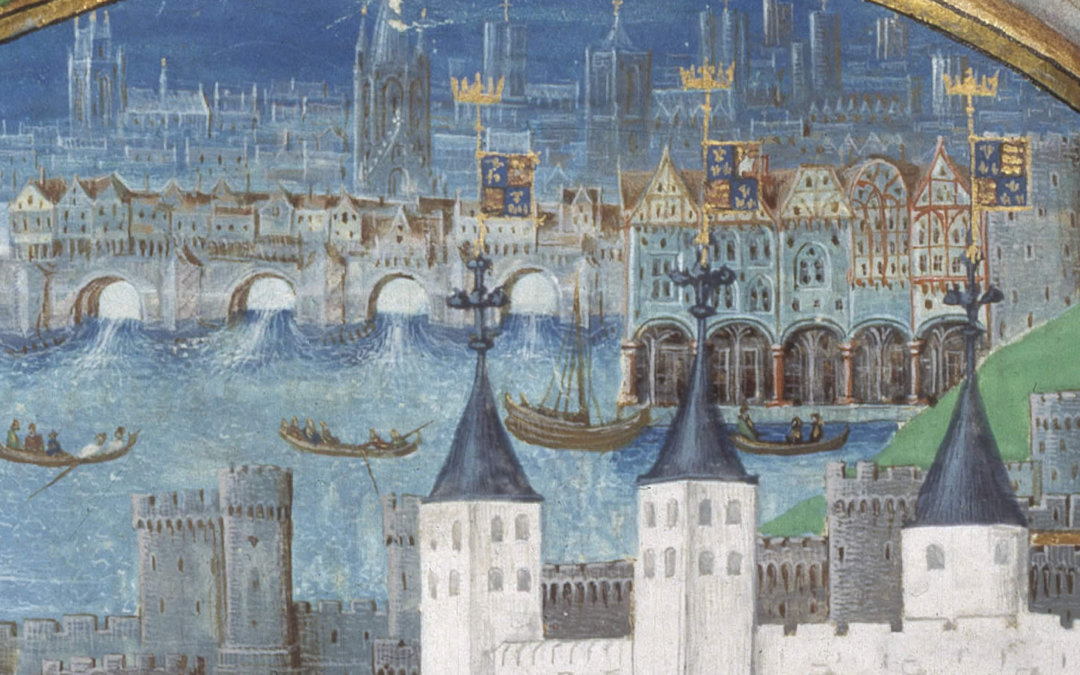The IHR’s Centre for the History of People, Place and Community has been carrying out some exploratory research on the potential of analysing London’s medieval customs accounts digitally. Detailed, or ‘particular’ customs accounts recorded immense detail about the goods and practices of trade, giving an unparalleled insight into the medieval material world and international networks. The challenge of these sources, however, is in their sheer scale, and their complexity. Eliot Benbow has been undertaking proof-of-concept work as part an IHR Internship.
The London Customs Accounts can provide amazingly detailed insights into the material and trading life of later medieval London; they can shed new light on the material culture of late medieval imports and the role of women as medieval merchants. They offer a hitherto mostly untapped resource for the daily patterns of mercantile life providing insights into the lives and careers of tens of thousands of merchants, especially as they can be effectively linked with other sources.
London’s main trading partner in the later fifteenth century, other than Calais, was the port of Antwerp. This connection is vividly expressed in the career of Laurence Swarfeld [Zwaervelt]. Swarfeld began his career as an Antwerp Haberdasher but would embark on an astounding multinational career that both crossed the Channel and expanded outside the bounds of his original trade.
Swarfeld first appears in the London Customs Accounts in 1466. He shipped a number of cargoes of miscellaneous goods or haberdashery. For instance, in the ship of Peter Frysh, arriving from Middelburg on 7th January, 1466 he imported 1 chest with 2 bales of paper depicti (painted, or perhaps printed papers – likely containing images) and 2 bales of combs valued at £3. He was a relatively regular importer of paper in these accounts. He also imported objects like bells, needles and thread.[i] Like so many Low Countries and English merchants of this period, his exports chiefly consisted of the cloth that forms such a large portion of the Customs Accounts.
Swarfeld imported goods alongside several prominent London Haberdashers, including Robert Billesdon, who later became Mayor of London (the first of his craft to do so) in 1483-4. Others included William Welbeck and Richard Aubrey. Another cargo from 1466 was imported alongside that of William Caxton, the London Mercer and later, the famed printer. These merchants were all also members of the Merchant Adventurers, the wealthy group who increasingly controlled and regulated London and English trade with the Low Countries in the fifteenth century.[ii]
Laurence’s career developed rapidly. In 1468, he acquired denizen status. This granted exemption from a number of taxes and customs, giving broadly the same status of “indigenous” or English merchants. [JC1] This was a mechanism used by many “alien” merchants in this period. This was recorded in the Patent Rolls meaning that we can also find Swarfeld in the England’s Immigrants Database.
This new status meant that Swarfeld was no longer charged the Petty Custom on his imports, as English and denizen merchants were exempt from this charge. He did still, however, have to pay Tunnage and Poundage, a form of customs charge that all merchants other than members of the German Hansa had to pay. Unfortunately, there are no surviving Tunnage and Poundage accounts from 29th September 1466 – 21st August 1485. His appearances in the Customs Accounts after 1466 are restricted to his cloth exports in the Petty Custom – a useful reminder that presences and absences of merchants in the Customs Accounts need to be contextualised using other sources.
Swarfield’s exports of cloth continued into the 1480’s. He appears repeatedly in the 1480-1 Petty Custom, in ships bound mainly for Antwerp, alongside a wide range of English Merchant adventurers including fellow Haberdashers such as Henry Wyngar, Robert Billesdon, William Geffrey, and a range of alien and Hanseatic merchants, particularly those of Cologne. [iii]
Looking beyond the customs accounts, we can see the connections between London and Antwerp powerfully expressed through Swarfeld’s fortunes. In 1480 he was given letters of safe passage by Edward IV, recorded in the archives of Bergen-op-Zoom describing him as “Laurentius Swarfeld, civis et haberdasscher civitatis nostre Londonie” – Laurence Swarfeld, citizen and haberdasher of our city of London.[iv] Laurence had therefore joined the London Haberdashers company, one of the first alien or alien origin merchants to do so. Many alien haberdashers operated in and around London in the fifteenth century and appear along with their Londoner colleagues in the Customs Accounts, often sharing space on the same ships. However, most others lived in Southwark rather than the City of London to escape the regulation and monopolies claimed by the City’s guilds and livery companies.
Other records show that not only had Laurence become a citizen of London and a Haberdasher, but that he also joined the Merchant Adventurers, the association of English merchants overseas, and was acting as their attorney in Antwerp. A record from Middleburg dated 1480 states that “Laureys van Zwaervelt, procuter de nacien alsnu van Ingehland – the “English nation” being a colloquial term for the English Merchant Adventurers in this period – “bogher ende vryman in Londen, resyderende in Antwerpen” – burgher and freeman in London, residing in Antwerp.[v] Proctuter suggests something along the lines of “proctor” i.e. a legal representative or attorney.[vi] This fascinating document shows that Laurence was utilising his developed knowledge of his birthplace – Antwerp and his adopted home – London to mediate between the two cities. He can be clearly seen as a mediator in a debt case from 1480.[vii]
Unfortunately, Swarfeld disappears from the Customs Accounts, or indeed in other documents, after 1481. However, I would argue that his career trajectory is a natural outcome of decades of growth in both the London to Antwerp trading route, and the growth of the role of the Merchant Adventurers. Laurence was not the first alien merchant to become a prominent mediator of English trade and conflict resolution. Florentine Gerard Caniziani had provided similar services in the 1470’s and had acted as a major financier to Edward IV. These networks of trading, financial and legal knowledge were highly important to the conduct of English trade and in the mediation of conflicts and disputes.
London’s medieval customs accounts allow us to consider the practical evidence of how trading mechanisms and networks developed as well as how they are reflected in changing patterns of trade. Furthermore, all these processes, networks and activities were carried out by people, individuals, families and companies many of whom can be seen in the accounts with a greater clarity and regularity, than they can be seen in other forms of documentation. The day-to-day facilitation of trade and the lives and the careers of the thousands of merchants major and minor who called London a home and a marketplace form a core aspect of the accounts and can tell us a great deal about living and trading in later medieval England.
[i] Stuart Jenks, ed., London Customs Accounts, 3:2 (Lübeck, 2019), Tunnage and Poundage Particulars of Account and Controlment Roll (E122/194/18 & E122/85/10) 19 Nov. 1465–6 Apr. 1466, pp. 1-60 (pp. 19, 20, 24, 25, 27, 28, 35, 51, 56).
[ii] Anne F. Sutton, The Merchant Adventurers of England: their Origins and the Mercers’ Company of London’, Historical Research, 75 (2002), 38–48; Eleanora Carus-Wilson, ‘The origins and early development of the Merchant Adventurers’ organisation in London as shown in their own medieval records’, in eadem, Medieval Merchant Venturers: Collected Studies (London, 1954), pp. 143-182.
[iii] Stuart Jenks, ed., London Customs Accounts, 3:5 (Lübeck, 2016), pp. 1-248. (pp. 162, 164, 167, 195, 221, 230, 236); Henry S. Cobb, ed., The Overseas Trade of London Exchequer Customs Accounts 1480-1, London Record Society, 27 (London, 1990). Accessible at British History Online: https://www.british-history.ac.uk/london-record-soc/vol27 [Accessed: 26/01/2024], ships 450-1, 456, 505, 568, 573, 577.
[iv] H.J. Smit, ed., Bronnen tot de geschiedenis van den handel met Engeland, Schotland en Ierland, 1150-1485, Rijks Geschiedkundige Publicatien,65 and 66(s’Gravenhage, 1928), vol. 66, pp. 1168-1169.
[v] Smit, ed., Bronnen, pp. 1163-1164.
[vi] This is the significance given to Swarfeld by Nellie Kerling, who was, as far as I am aware, the only scholar to have noted his presence: N. J. M. Kerling, Commercial Relations of Holland and Zeeland with England from the Late 13th Century to the Close of the Middle Ages (Leiden, 1954), pp. 165-6.
[vii] Smit, ed., Bronnen, pp. 1163-1164. The London merchant William Baldry had been the victim of cargo seizure by Bave Noutsson of Vlissingen, who accused Baldry of owing him a substantial sum of money.


